An agency rate card is a document outlining an agency's pricing structure for various services, crucial for transparency and client communication. In 2025, creating an effective rate card involves understanding service costs, setting competitive rates, and regularly updating information to reflect market changes. Key elements include clear pricing, service descriptions, and terms. Agencies should leverage rate cards to enhance client trust and streamline project estimates. Regular reviews and integration with estimation tools ensure accuracy and relevance, ultimately boosting agency profitability and client satisfaction.
Every agency can benefit from clear and concise agency rate cards. These simple documents provide a wealth of advantages, particularly as cost transparency is increasingly important in today’s world. But creating and managing rate cards for newer and smaller agencies can be challenging.
This guide will explore exactly how to create and manage your agency rate card in 2025.
Introduction
Before worrying about the nitty-gritty of agency rate card design, it’s important to understand what rate cards are. So, let’s begin with the basics.
An agency rate card is a document that outlines the agency’s pricing structure. In other words, it shows how much the agency charges for each of its various services, similar to a freelancer’s hourly contract.
For example, let’s imagine a digital marketing agency rate card. It might include a list of relevant services, such as “SEO Audit” or “Blog Writing,” along with the respective charges for each of those services.

Generally speaking, these documents are quite simple. They consist of little more than service names and related costs. However, there are various ways in which to present those costs. Some agencies may have flat rates per service, others may charge by the hour, etc. Agency rate cards also vary in aesthetics. Some are black and white price tables, while others incorporate color and branding.
How to create a rate card
Creating your own Agency Rate card is easy. Follow these steps to efficiently set up your account and create a rate card that you can readily share with your clients.
Step 1: Sign up on Bonsai

Sign up for Bonsai using this link and complete the registration process. You can also create a free account by signing up with Google. You will be asked to provide some basic information about yourself and your agency.
If you have an existing account, you can simply log in to your account then proceed to the next step.
Step 2: Create your services

After logging in, find the Services section from the menu on the left then click the Add Service button. You can then select from the list of Services Templates that you can customize.
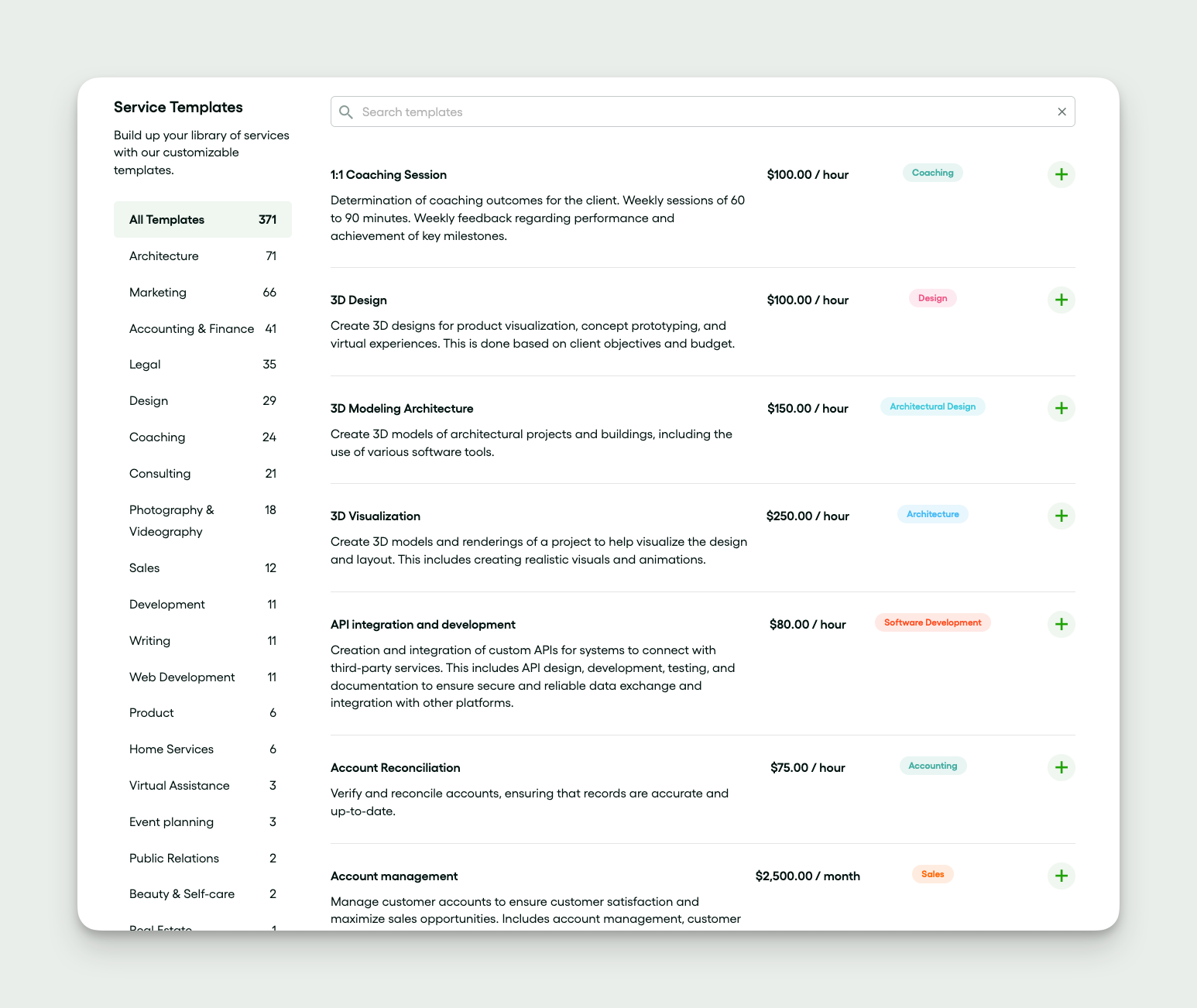
However, if you prefer to create from scratch, you can do so by clicking the Create from scratch button.
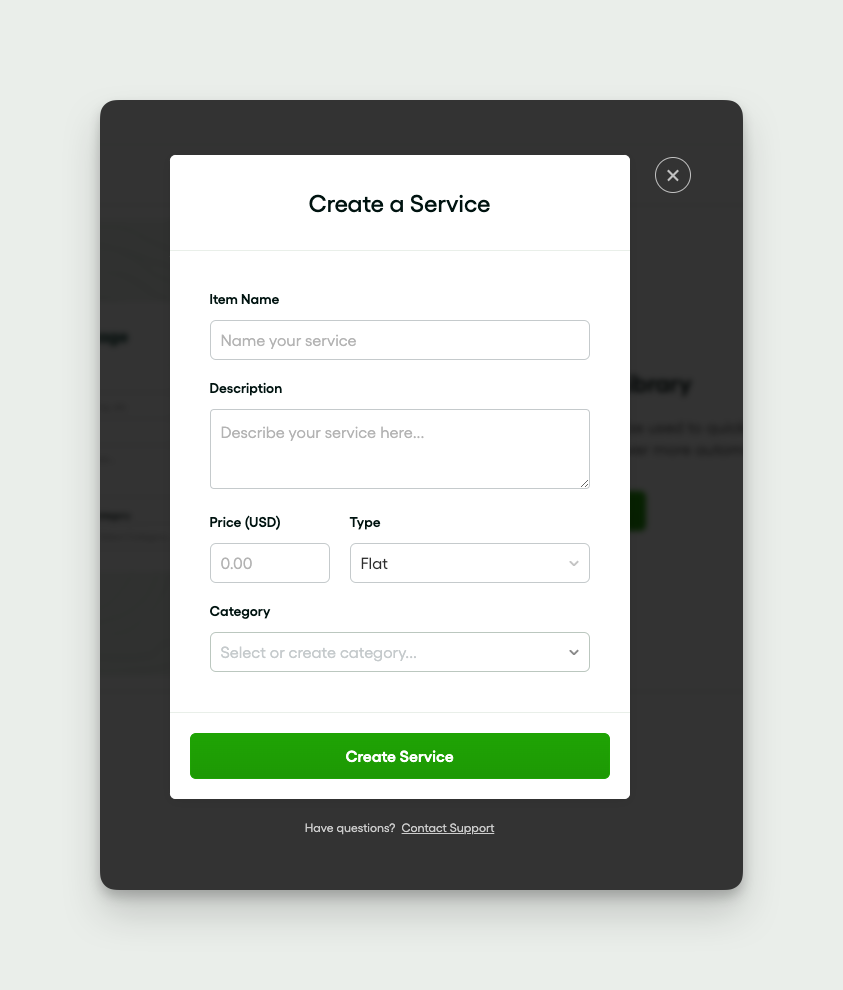
Then proceed to add your own services, give it a clear and descriptive name like “Graphic Design” for example. Then write a brief description that outlines what the service includes. Next, you have to decide on a pricing structure (e.g., per hour, per day, etc.) and specify the rate. Lastly, select or add the category that best fits the service your agency is offering. When you’re done, click the Create Service button.
If you offer more than one service, repeat this process for each to create a comprehensive list of what your agency provides.
Step 3: Create a proposal as your agency rate card
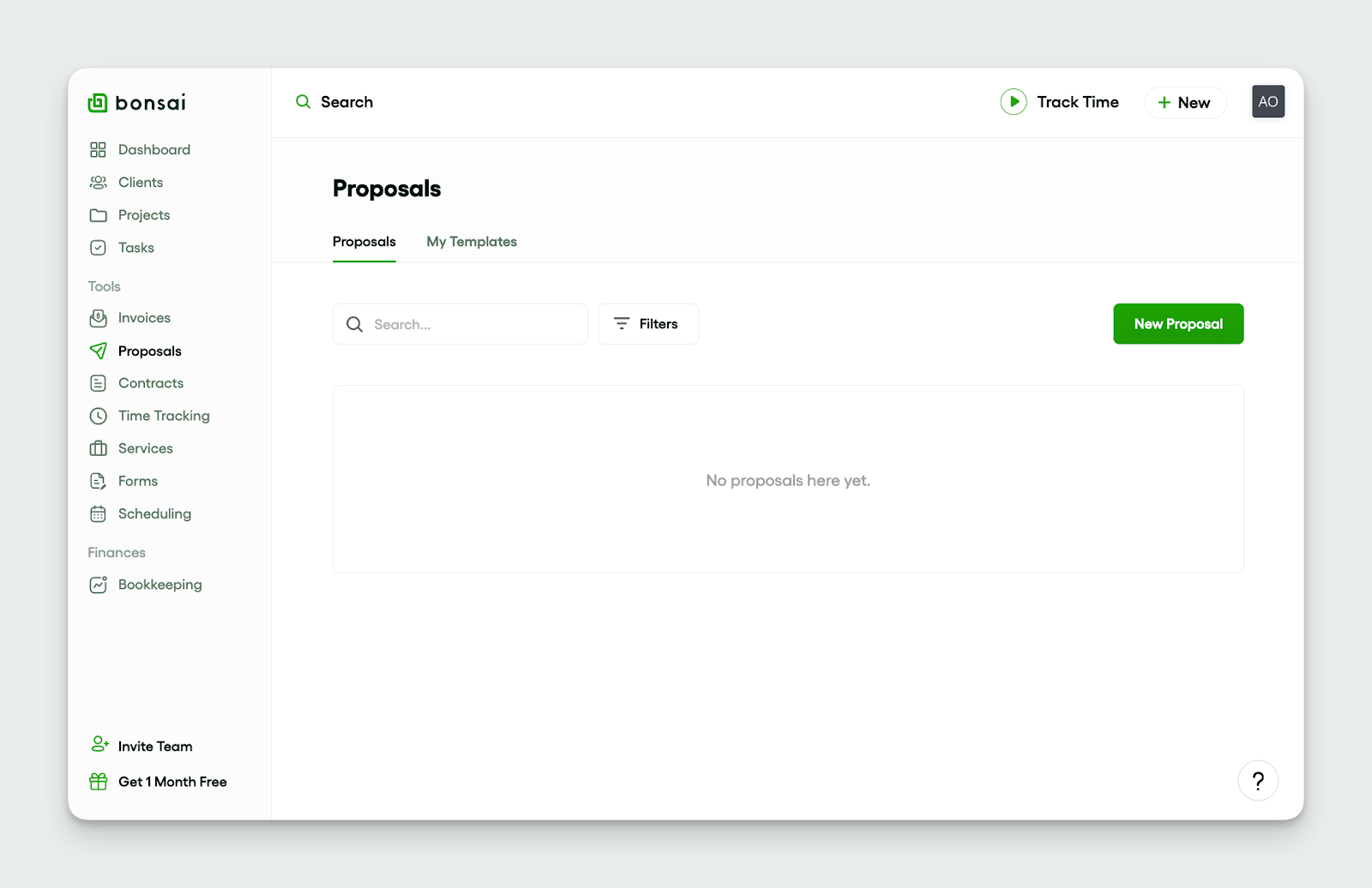
Go to the proposal section and click the Create a Proposal button. Then select the option for a ‘blank proposal’ to build your rate card from scratch. Then, you will be asked to add a client or select an existing one and then add the name of your project.
Scroll down and find the Fee Summary section then add each service you wish to include in your agency rate card. For instance, if you are offering a “Graphic Design” service at $200 per item, select it and it should automatically appear in the proposal.
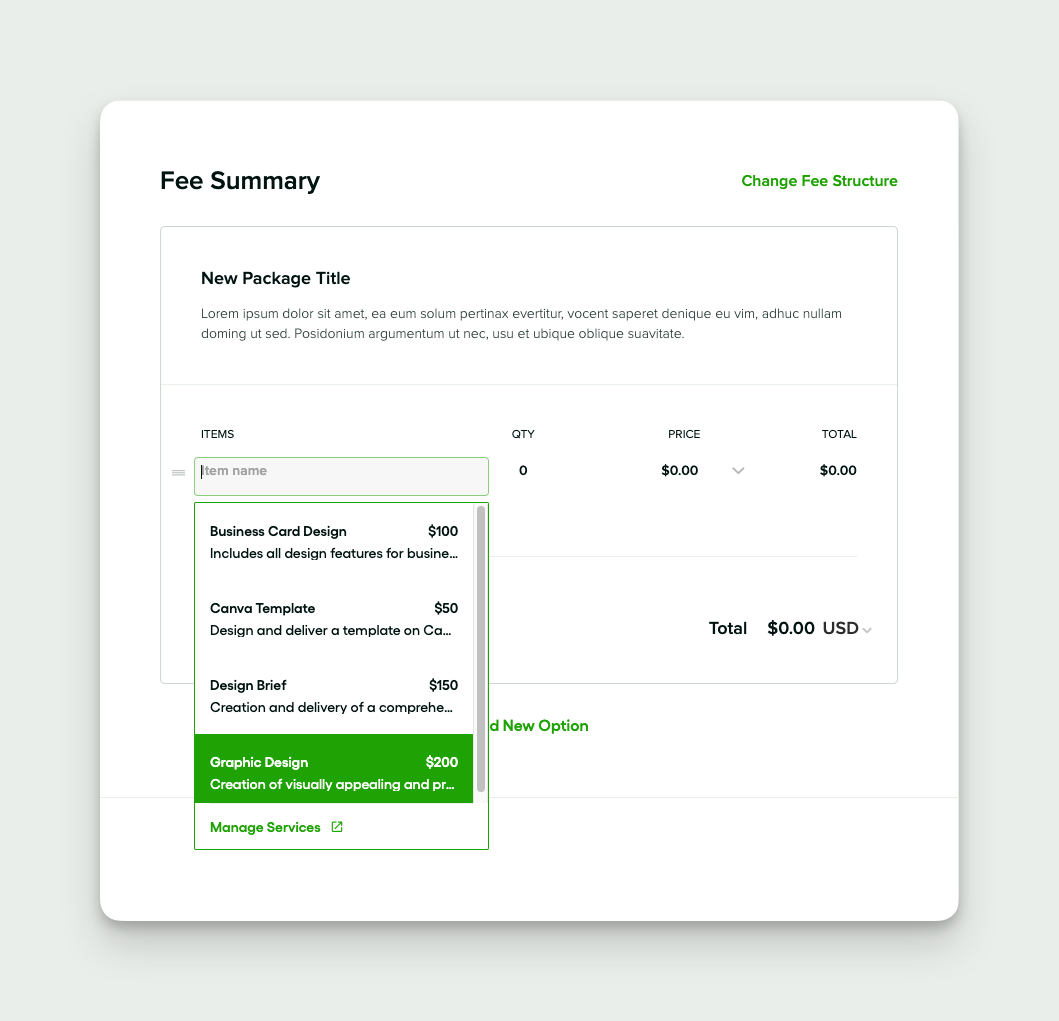
This will serve as your rate card, displaying all the services and their rates clearly.
Step 4: Save your rate card as a template
Once your agency rate card is complete, save it as a template. You can download it as a PDF or you can also send it to your clients directly from Bonsai. Utilize your saved templates to quickly respond to client inquiries when they ask for your agency rate card.
Why should you use a rate card?
Here are a few reasons why agency rate cards matter so much.
Reason 1 - Transparency
When approaching an agency, clients don’t want to jump through hoops or wait around to find out how much they’ll have to spend. Instead, they generally prefer to know right away what kinds of rates the agency charges. This allows them to quickly work out if those rates match their own budget, and make a decision about whether or not to proceed.
Having a rate card obviously helps in this regard. It communicates your agency’s pricing plans directly to your customers, with no obfuscation or delay. If customers are happy with the proposed rates, they can get in touch. If not, they’ll look elsewhere. It helps to avoid any wasted time for both the agency and its prospective clients.
Reason 2 – Clarity
When it’s time to get paid for work done, agencies are often grateful for the existence of their rate cards. The cards make it clear exactly how much is charged per service. This helps to mitigate the risk of clients attempting to pay less than the agreed amount. It also reduces the odds of clients trying to negotiate some kind of deal or discount.
Given that 58% of clients are eager to discuss pricing on the very first call, having an agency rate card is essential. It clarifies everything about the payment process, removing any doubt about how much is expected. This helps to facilitate clearer communication between an agency and its clients, while also avoiding unpleasant surprises for either party when payment is due.
Reason 3 – Competition
In many industries, competition is fiercer than ever. There are in excess of 14,000 advertising agencies in the U.S. alone, for example. With so many firms to choose from, clients will often shop around to find those that offer the best rates. And they’ll often appreciate agencies that provide clear and accessible rate cards for them to consult.
Creating and managing your agency rate card can prove vital for keeping up with the competition. You can adjust your rates accordingly to match industry trends, or keep an eye on rival firms and make sure you’re beating them for value. All of this helps agencies secure more clients, more work, and ultimately, more profits.
Understanding your agency’s value

The first step when creating an agency rate card is to determine the value of the services your agency has to offer. Unfortunately, in any line of work, from architect to accountant, calculating fair and competitive rates is often a challenge. There are several factors to take into account, starting off with the experience and expertise of your particular firm.
Naturally, agencies with a proven track record of success and years of experience in the field will typically be able to charge more. They can rely on their reputation to reinforce higher prices. Meanwhile, smaller and newer firms may have to cope with lower prices in the early stages. This can help to attract initial clients and improve the agency’s standing so it can increase its prices later on.
It’s also recommended to compare market rates at this stage. That means checking out the competition and getting a rough idea of how much other agencies are charging for the same service.
Let’s imagine you’re running an agency that offers SEO content creation, for example. You won’t want to simply imagine a cost per 1,000-word blog post off the top of your head. Instead, you’ll need to do some research. Look at other content creation firms and digital marketing agencies. Consult their rate cards and see how much they expect per post. Use that as a benchmark to set your own rate.
This is also a good time to consider your agency’s unique selling points, or USPs. Perhaps your agency has its own in-house apps or tools to support your services. Maybe your firm specializes in a specific niche. Or maybe you have some other element or aspect that sets you apart from the crowd. Consider what makes your agency unique and how that may impact the prices of certain services.
For instance, let’s imagine an agency that is highly-specialized in the field of local SEO. It might charge standard or even cheaper-than-standard rates for most services. But for its specialist local SEO campaigns, it could charge a little extra than the average.
Determining pricing structures for the rate card

You’ll also need to work out the right kind of pricing structure for each item included on your agency rate card. That way, when it comes to invoicing your clients, you should find it much easier to calculate the correct prices.
First, draw up a list of all the services your agency offers. For a digital marketing agency, that might include content marketing, SEO, social media marketing, email marketing, web design, and reputation management.
Then, go through each of the items on the list, working out whether it’s best to charge by the hour, the project, or in another way. For example, let’s say you offer marketing consultancy services. You could charge those by the hour. But you might also offer blog post writing. For that, it’s usually simpler to charge per post (or per 1,000 words).
Value-based pricing
You might even have different pricing tiers for each of your services, or for working with agents of different levels. For example, imagine you offer social media marketing with a standard monthly rate of $1,000. You could also offer a “Premium” version of that service, in which clients can have their social media platforms managed by a more experienced agent. For that, you could charge $1,500.
This is where value-based pricing comes into play. Some services tend to have similar rates across the industry, like SEO audits. Other services, which can vary much more greatly in terms of quality and results, may have more dynamic pricing. Customers will be willing to pay quite a lot more for those kinds of services, giving agencies more leeway in terms of their rates and price structures.
For example, the cost of website design can vary massively from agency to agency. A basic service might only cost a few hundred dollars. But if you can offer high-end web design incorporating SEO and eCommerce elements, carried out by a trusted professional with years of experience, you’ll obviously be able to charge more.
Additional pricing factors
Your agency rate card could also include additional pricing factors, like possible discounts for larger orders or longer projects. Perhaps your agency also offers service “bundles,” too, in which multiple services can be purchased together at a reduced rate. Again, this is something to think about and to factor into your rate card layout and design.
Additionally, you may want to add retainer agreements to your rate card, especially if you hope to build long-term client relationships. Having clear retainer rates will give your most loyal customers the information they need before beginning long-term or ongoing projects with you.
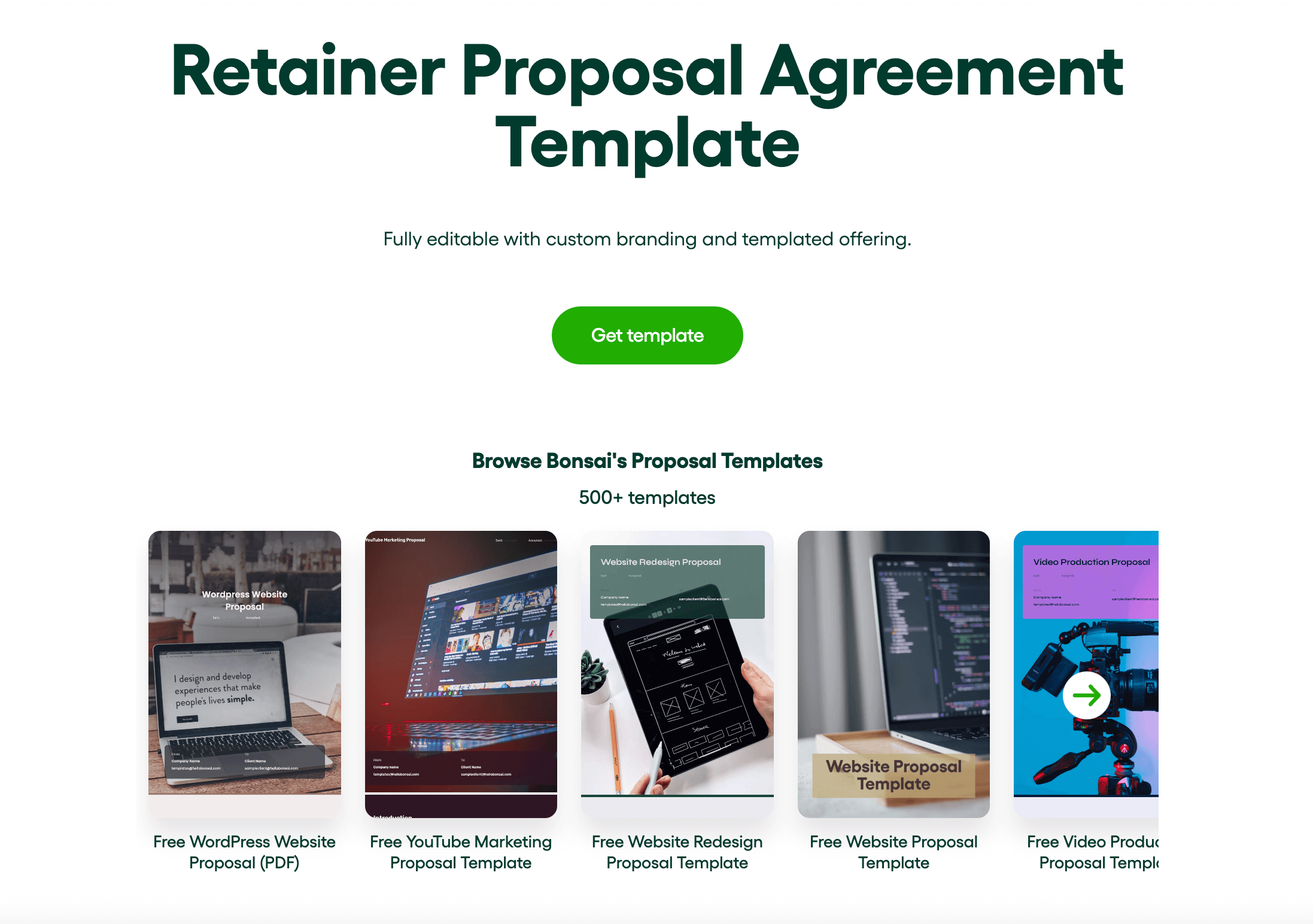
Breakdown of services to include in your rate card

Every marketing agency rate card should be clear and easy for clients to read. It requires good structure and a sensible, smart layout. So, the next step of creating your card is to categorize the various services you offer.
Categorizing your services
Make a list of all the services your agency offers. Then, try to divide them into clear categories. Depending on the work you do, the categories might be quite broad, such as “Design” and “Consulting.” Alternatively, they may be more specific, like “Facebook” and “Content Creation.” It’s up to each agency to figure out relevant and appropriate categories for its range of services.
You may also consider adding detailed descriptions of each service. Some rate cards don’t include descriptions at all, but it can be worth including them. It adds clarity, making it crystal clear what each service entails and what customers can expect to get for their money. A couple of sentences about each service should suffice.
Bundling and value propositions
As touched on earlier, you may also wish to consider providing “bundles” or “packages” of services with discounted rates. For example, you could offer individual SEO site audits and site optimization as separate services. Then, you could also offer an “Audit + Optimization” bundle for a little less than the combined individual costs of those two services.
When it comes to offering value propositions, it’s important to think logically. Consider the kinds of services that clients are likely to buy all-in-one-go. Look at services that are connected or those that complement one another. Alternatively, look back at your bookkeeping records and see which services clients tended to buy at the same time. Use that info to build bundles your customers want.

Transparency and flexibility in pricing
Arguably the No. 1 point of designing an agency rate card is to make your agency’s pricing more transparent. As such, it stands to reason that the card needs to be as clear and honest as possible. This is why the previous steps are so important. You have to take the necessary time to detail the services you offer, do your research, and decide exactly how much you wish to charge for them.
The aforementioned service descriptions should help. They can clarify what’s included with each service and are particularly useful for services which may seem a little vague. For example, returning to the idea of blog posts writing, you might charge $50 for a single 1,000-word blog post. It’s worth noting in the description if that rate also includes edits and revisions, and if so, how many.
Additional charges
There may be times when clients request additional work or out-of-scope add-ons to the services you provide. You may not be able to account for every possible demand your clients could have, but it’s wise to consider these possible bonus charges when drafting your rate card. The more detail you can put into the card and the more possible charges you mention, the less likely clients will ask price-related questions or try to negotiate.
Custom quotes
Of course, there may be even jobs that simply don’t fit in with your typical services and rates, at all. Clients may come to you with one-off requests or custom project concepts. They might have worked with you in the past for something like web design or SEO. And they might want to call on your services again for something connected, but different to the work you usually do.
Naturally, your agency rate card can’t include all of these possibilities and concepts. However, you can quite simply include a line or two at the base of the card to address custom projects. You could, for instance, add a small section entitled “Custom” and state “Prices for custom projects are calculated on a project-by-project basis. Contact us to learn more.”
Designing the rate card

With the content of your agency rate card established, it’s time to focus on the card’s design. In the same way a beautiful business card can help professionals broaden their networks, a smart rate card can help an agency get ahead. For that reason, it’s absolutely worth putting in the time to create a card that conveys pricing information in an attractive, engaging way.
Visual appeal
Like any other document tied to your agency, your rate card should be aligned with your brand’s visual identity. If you tend to use the same font style or color on all of your documents, for instance, carry that over into your rate card, too. Additionally, add branding elements, like your logo or other imagery at the top of the document to help it stand out from other rate cards.
However, while a logo or brand-related header is a fine addition, it’s important to avoid visual clutter. Remember, agency rate cards are informational documents, designed to convey pricing details. Don’t add any visual elements, like graphics and images, which could detract from the info. Otherwise, you run the risk of making your rate card far less effective or even difficult to read.
Format and structure
In terms of format, you’ve got two main options to pick from for you rate card: a table or a list. A lot of rate cards take the form of tables, with clear grids, rows, and columns showing the names of each service and its respective price. Others opt for more minimalistic lists, with the name of the service, an optional description, and the price.
Both formats can work equally well, but it all depends on the type, complexity, and number of services provided, as well as the desired effect. Tables have the advantage of being more detailed and clearer, with more room to talk about add-on charges, bundles, and so on. Lists are simple and streamlined, but may not provide quite as much in-depth info about each service.
Digital vs. print
Finally, when finalizing your agency rate card, you’ll have to decide between digital or print versions, or both. Again, there’s no clear “best option.” It all depends on the type of work your agency does. If you meet the vast majority of your customers online, digital documents may be best. If you have more sit-down, in-person meetings, it helps to have print versions to hand out.
You may even want to create two different versions of your agency rate card. The print version could be simpler and fit on a single page to easily hand out at conferences or trade shows. The digital version, meanwhile, could be more complex. Using templates is a great way to get started with your designs and can help you save a lot of time.
Effective communication of your rates

Once you’ve got an agency rate card, you might be wondering about the best ways to use it to communicate your agency rates. Well, the first step is to share your rate card directly via your website. However, given the ever-changing nature of many agency pricing models, you may prefer to keep the rate card under wraps and only show it to clients on a need-to-know basis.
For instance, it’s a handy document to share during pitches or meetings with your clients, as well as one to consult during sales calls. Since a lot of different employees might be consulting and using the rate card, it’s also worth reviewing with your staff. Educate the team on the specifics of the rate card and the right ways to discuss prices with clients.
Regular updates are crucial
In industries like marketing, prices change often. You might have to increase your rates in line with inflation, for example. Or, as your company grows in reputation and popularity, you can increase the prices you charge accordingly. That’s why it’s also strongly recommended to review your agency rate card on a regular basis, adjusting prices as and when needed. You may also need to add or remove services to suit your changing service menu.
Legal considerations and disclaimers
There are also legal considerations to take into account in regard to creating and managing agency rate cards. If certain terms are left out of the card or the pricing information is too vague, your agency may have to deal with angry clients and even the risk of legal action.
For example, a client might have an out-of-date rate card for your agency. They might use that to work out their budget and then place an order with your company, unaware that your prices have changed. Then, when it comes time to pay and invoice the client, they could be confused and frustrated if the price is higher than expected.
Make sure to include relevant dates on all agency rate cards, along with disclaimers to say that prices are subject to change. You can include a message encouraging clients to contact your agency to confirm the latest and most accurate prices. Terms should also be established for when payment is due and how it should be made, as well as handling of returns or cancellations.
Summing up: The value of agency rate cards
The importance of agency rate cards can’t be understated. Many agency owners agree that having clear rate cards helps to simplify and streamline large parts of their client relations. It makes it easier for clients to manage their budgets accordingly, as well as providing much-needed transparency and clarity to avoid any payment-related conflicts.
If you’re running or in the process of setting up an agency, it’s certainly worth taking the time to design a rate card. Using Bonsai’s handy templates is a great way to get started, and our business management software also helps you get paid at the right rates, quickly and conveniently. Sign up for your free trial today or contact the Bonsai team to learn more.

.webp)





